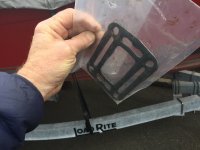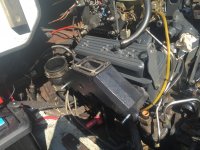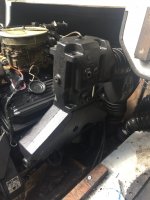I'm a newbie to this forum and not a mechanic but was hoping some experts on here might be able to validate our theory and plan with our milky oil issue.






We've owned our boat about six years and at the end of last summer, the boat died on us when towing a skiier. Temp was fine. It would turn over and not start. Tried lots of things and it actually started running again after we started towing it back. In any case, the boat repair shop said fuel pump was bad so replaced and confirmed all good with sea trial. We picked it up and didn't use it again last year. We live in the Seattle area so pretty mild winters and we store it in an insulated basement garage where there is just no way it can freeze in there. Regardless, my husband always runs the pink antifreeze through the motor and fogs the carb before storing it in the garage. He also lowers the motor down to floor level. Yes, not perfect winterization, but we figured even the anti-freeze was probably more than it needed since it was in an insulated garage.
When he pulled it out last month to get ready for the season, he hooked it up to the garden hose and ran the motor about 10 min to make sure it was running fine. He then let it cool and went to change the oil and found it milky. He drained it anyway and added new. Ran again about 10 mins and oil was milky again, like Bailey's irish cream. Yikes!
Our friend knows motors well so they were pretty sure the heads were cracked or the head gasket was bad so they decided to take the motor apart. In hindsight we realize we should have done a compression test and other stuff but too late. So big mistake there but too late now.
Upon first inspection by the two of them, nothing seemed terribly wrong. So we took the boat disassembled to a boat repair shop and they were certain the block was cracked. The thing is, that made NO SENSE to us given how it was stored over the winter. We took it home and people advised us to clean the valley so it is spotless and then re-inspect. We were told almost always the crack will be there. After doing this, there are simply no visible cracks we can see (see photos ).
The next step is we took the parts to a local machine shop and they were super helpful. Immediately they saw that the intake manifold must have been machined by a previous owner because the surface had ridges instead of being smooth. The machine shop guy couldn't believe how poorly it was machined with the grooves. He also showed us where metal was worn away two places (see pictures). He said with the engine pressure, he is quite certain that is the source of water getting in.
As for the heads, we are having them pressure checked by the machine shop and we will know the results Monday.
Given all of this, we are thinking the following:
1. Water is almost certainly coming in from the intake manifold - replace the entire thing (people suggested Edelbrock brand).
2. We see two light brown areas on one corner of the block (see photo) so are wondering if the head gasket might also be leaking some. Would that light brown indicate such? In any case, head gasket will be replaced.
3. If heads are bad, replace, otherwise no action needed
4. Put engine back together and pray the issue is fixed
Oh, and while we are at it, we will replace the exhaust manifolds as we don't think that has ever been done and we've heard freshwater boats should have this done every 10 years.
Question: We are petrified we will put all of the labor into putting the engine back together and still end up with milky oil. Are we missing anything? Any other suggestions? It just seems so unlikely at this point the block is cracked and that repair is so major, costly and lengthy. Are we doing the right thing?






We've owned our boat about six years and at the end of last summer, the boat died on us when towing a skiier. Temp was fine. It would turn over and not start. Tried lots of things and it actually started running again after we started towing it back. In any case, the boat repair shop said fuel pump was bad so replaced and confirmed all good with sea trial. We picked it up and didn't use it again last year. We live in the Seattle area so pretty mild winters and we store it in an insulated basement garage where there is just no way it can freeze in there. Regardless, my husband always runs the pink antifreeze through the motor and fogs the carb before storing it in the garage. He also lowers the motor down to floor level. Yes, not perfect winterization, but we figured even the anti-freeze was probably more than it needed since it was in an insulated garage.
When he pulled it out last month to get ready for the season, he hooked it up to the garden hose and ran the motor about 10 min to make sure it was running fine. He then let it cool and went to change the oil and found it milky. He drained it anyway and added new. Ran again about 10 mins and oil was milky again, like Bailey's irish cream. Yikes!
Our friend knows motors well so they were pretty sure the heads were cracked or the head gasket was bad so they decided to take the motor apart. In hindsight we realize we should have done a compression test and other stuff but too late. So big mistake there but too late now.
Upon first inspection by the two of them, nothing seemed terribly wrong. So we took the boat disassembled to a boat repair shop and they were certain the block was cracked. The thing is, that made NO SENSE to us given how it was stored over the winter. We took it home and people advised us to clean the valley so it is spotless and then re-inspect. We were told almost always the crack will be there. After doing this, there are simply no visible cracks we can see (see photos ).
The next step is we took the parts to a local machine shop and they were super helpful. Immediately they saw that the intake manifold must have been machined by a previous owner because the surface had ridges instead of being smooth. The machine shop guy couldn't believe how poorly it was machined with the grooves. He also showed us where metal was worn away two places (see pictures). He said with the engine pressure, he is quite certain that is the source of water getting in.
As for the heads, we are having them pressure checked by the machine shop and we will know the results Monday.
Given all of this, we are thinking the following:
1. Water is almost certainly coming in from the intake manifold - replace the entire thing (people suggested Edelbrock brand).
2. We see two light brown areas on one corner of the block (see photo) so are wondering if the head gasket might also be leaking some. Would that light brown indicate such? In any case, head gasket will be replaced.
3. If heads are bad, replace, otherwise no action needed
4. Put engine back together and pray the issue is fixed
Oh, and while we are at it, we will replace the exhaust manifolds as we don't think that has ever been done and we've heard freshwater boats should have this done every 10 years.
Question: We are petrified we will put all of the labor into putting the engine back together and still end up with milky oil. Are we missing anything? Any other suggestions? It just seems so unlikely at this point the block is cracked and that repair is so major, costly and lengthy. Are we doing the right thing?






















